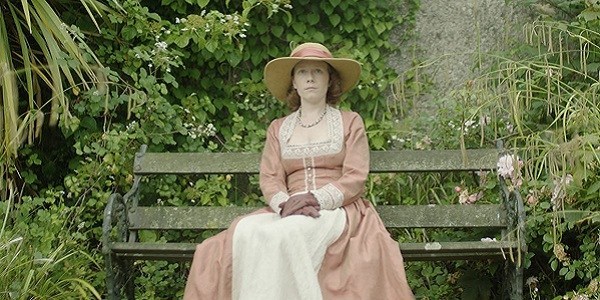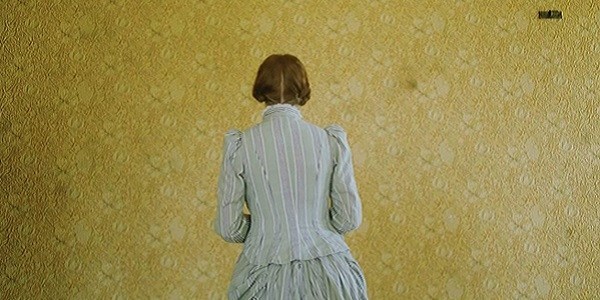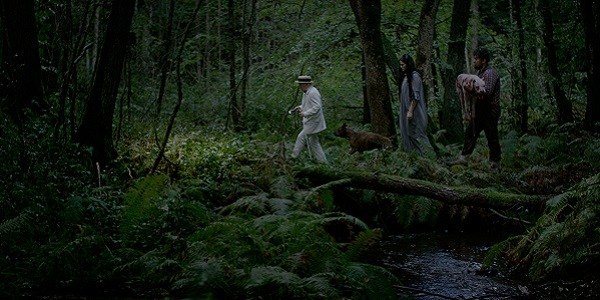THE YELLOW WALLPAPER: A Flawed Reimagining of a Feminist Classic
The most famous work by the progressive feminist writer Charlotte Perkins Gilman is her short story “The Yellow Wallpaper,” published in 1892. Written after Gilman had experienced a bout of postpartum depression that doctors attempted to treat by forcing her to do as little as possible — the then much-vaunted “rest cure”— the story uses elements of psychological and supernatural horror to tell the tale of a woman writer who has been taken to a remote estate to recover from an unknown illness. Forbidden from writing or caring for her own child (though the latter comes as somewhat of a relief), our narrator descends into darkness, her “rest cure” doing more to damage her mental health than her work ever could.
It is a mark of Gilman’s genius that she manages to pack a feature-length film’s worth of feminist commentary and gothic atmosphere into such a succinct little story, and her critique of men’s misguided attempts to diagnose and treat women’s health problems — both mental and physical — remains tragically relevant to this day. So, it’s no wonder that “The Yellow Wallpaper” has been adapted for the screen multiple times in the past. This latest version, a collaboration between partners Alexandra Loreth (writer/producer/star) and Kevin Pontuti (writer/producer/director), is clearly a very personal endeavor. Yet despite the film’s impressive recreation of the claustrophobic world described in Gilman’s story, The Yellow Wallpaper lacks much of the emotional impact of her writing.
Peeling Away From Reality
Jane (Loreth) has been taken to a crumbling mansion in the countryside by her overbearing doctor husband, John (Joe Mullins) to recover her strength. While Jane thinks her condition would be better served by engaging in invigorating physical and mental activity, John insists that it is much better for her to spend her days lying in bed—and he forbids her from writing, claiming that the mental exertion of doing so will exaggerate her illness. Instead, he encourages her to recover her strength as soon as possible so she can focus on developing her talents as a mother.

So, Jane begins scribbling to herself in secret, particularly about the grotesque yellow wallpaper that covers the room to which John has essentially confined her. It’s an expansive room, with many windows —but the windows are covered with bars, and the bed is nailed to the floor. John tells her the room used to be a nursery, but it looks and feels far more like a cage that was used to keep another so-called madwoman away from anything that might light a fire in her belly.
Jane allows herself to be swallowed up by the undulating arabesques of the wallpaper, and the yellow stains that it leaves on her clothes, and the unpleasant odor that it leaves in her hair. Soon, she begins imagining that there is a woman trapped within the wallpaper, a woman struggling to get out—a woman as trapped as she is. Jane’s obsession threatens to become all-consuming, and without any other outlets for her prodigious imagination, it’s hard to imagine a way out.
The Horrors of the Patriarchy
From the first moment Jane and John appear on the screen, rumbling through the countryside in a carriage taking them to their fateful new home, one is easily swallowed up by the world created by the filmmakers of The Yellow Wallpaper. The costumes designed by Cathie McCellan are lovely to look at, particularly the day dresses worn by Jane as she creeps around the house and gardens while John is away, and the house itself is what any reader of Gilman’s would have imagined, right down to the titular wallpaper. The overall atmosphere is one of a gilded cage, pretty but increasingly suffused with panic.

However, the performances in The Yellow Wallpaper do not do this meticulously constructed world nor Gilman’s story justice. One wonders if the script’s use of dialogue direct from Gilman’s story actually ended up being more of a hindrance than a help, as the acting from all involved feels rather stilted. In particular, Mullins as the controlling husband and Jeanne O’Connor as Jennie, his sister, and the couple’s housekeeper, are difficult to believe in their roles; their performances often took me out of the story altogether.
Loreth in the leading role is better, for her understated performance can be seen as a reflection of the mental and emotional suffocation that Jane is currently experiencing; she also looks remarkable onscreen, her long red hair and pale skin giving her an ethereal vibe that suits the material. (One could easily see her in a film about, say, the Salem witch trials.) Also intriguing is Clara Harte as Mary, the nursemaid who may or may not be a figment of Jane’s imagination, a ghostly figure of comfort conjured up for her to confide in when no one else is willing to listen.
But, overall, the film’s performances are far too uneven to keep one as immersed in their world as one would like. I was also not a fan of the way The Yellow Wallpaper interpreted the story’s infamous climax, but to say more than that would be giving away too many spoilers. Suffice to say, while the ending of Gilman’s story leaves one feeling equal parts horrified and empowered, the film left me feeling little of either.
Conclusion
It may be partially my own fault for going in with such high expectations as a fan of the source material, but I was mostly disappointed by this reimagining of The Yellow Wallpaper. Perhaps those unfamiliar with the story will appreciate the film more. Nonetheless, while a respectful homage, it fails to elicit the same charge of feminist rage, coupled with fear, that Gilman’s story does.
What do you think? Have you read any of the stories of Charlotte Perkins Gilman? Share your thoughts in the comments below.
The Yellow Wallpaper premieres at Cinequest on March 20, 2021.
Watch The Yellow Wallpaper
Does content like this matter to you?
Become a Member and support film journalism. Unlock access to all of Film Inquiry`s great articles. Join a community of like-minded readers who are passionate about cinema – get access to our private members Network, give back to independent filmmakers, and more.
Join now!





